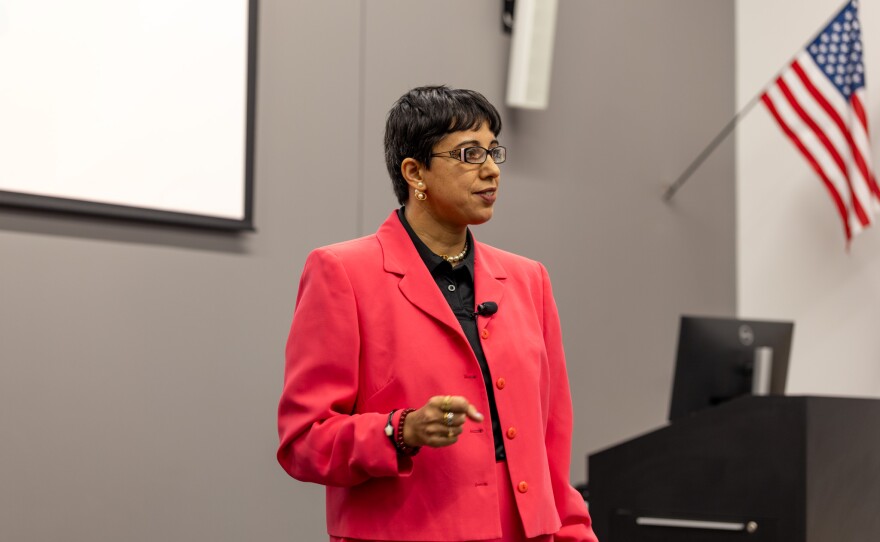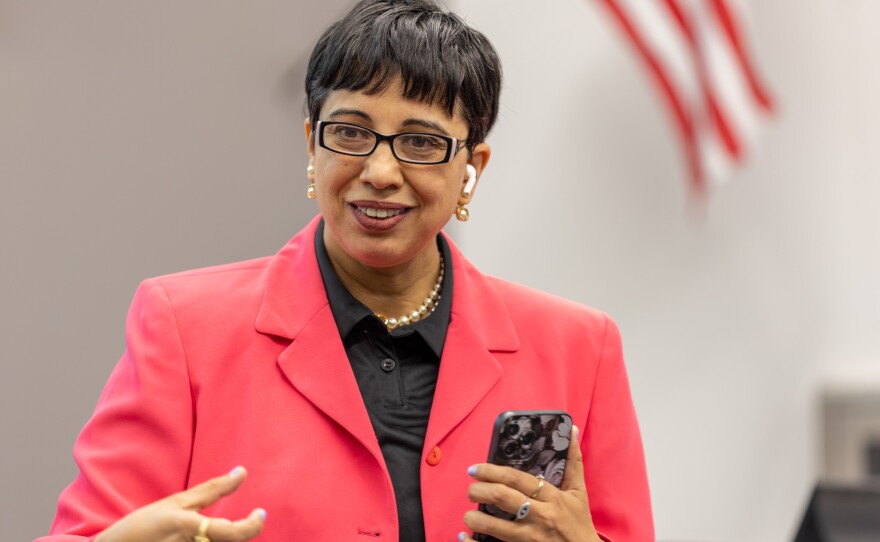With Arizona Western College President Dr. Daniel Corr expected to retire at the end of the academic year, the search for his successor is underway.
The college district governing board has since announced a sole preferred candidate: Dr. Reetika Dhawan.
As part of the consideration process, the college held four town halls open to the public—two in Yuma, one in Parker and one in San Luis. In them, Dhawan presented her vision for the college and shared how her background guides her leadership.
After her formal presentation, moderator Katheline Ocampo asked Dhawan a few prepared questions. Members of the public were able to submit questions in writing, from which Ocampo selected and asked aloud in the final part of the forums.
KAWC attended the first town hall in Yuma, which was packed. Once all of the seats in the lecture hall were taken up, folks took to standing along the sides.

Background
In her presentation, Dhawan shared she's a proud immigrant from northern India who "is so grateful to this country, to this community and this college for giving me every opportunity that you have given me today."
While in India, she earned two bachelor's degrees in education, and physics, chemistry and math. She also earned a master's in physics and taught at the university level.
Dhawan's American journey began in 2007, when she moved to Parker and began teaching physics and math at Parker High School. She soon after became a professor at AWC, first in La Paz and then Yuma.
For more than a decade, Dhawan taught math and physics courses. She eventually became co-chair for math and engineering and then in 2017, dean of career and technical education (CTE). Although she felt her knowledge was lacking going into the dean position, she learned a lot through the process.
Dhawan went on to become associate vice president and then vice president of workforce development and CTE. Today she is also CEO of AWC's Entrepreneurial College.
Dhawan's awards and recognitions are numerous, but they include: AWC Teacher of the Year, Flinn-Brown Fellow and ATHENA International Award.
"... these all honors all reflect when we work together, we uplift our community, we uplift our college, we uplift everyone," she said. "So that's what I believe in. It's not my achievement; it's our achievement of everyone how we work together."
Dhawan has also been credited for securing $60 million in grants for AWC, many of which she was able to name during a question from the public.
Dhawan's presentation slides from the town halls:
Leadership Style and Approach
Dhawan considers her leadership style to be service-driven, or "service over status." She shared that she's served and continues to serve on many boards, including the Arizona Impact Center, Southwest Technical Education District of Yuma, Greater Yuma Economic Development Corporation, Yuma Crossing National Heritage Area and Yuma County Airport Authority, Inc.
"... outside the college when I work, I work on building the college education, connecting them with industry and work-based experience learning and also working with opportunities for our college; that's what I believe in," she said. "And how I do that, I do by advocacy—whether it's for arts, whether it's for youth empowerment and whether it's for workforce. That's what I believe in it. And I engage Arizona Western College in the state and nationally. Why? Because we wanna make sure that we reflect what we do and they understand what we are doing great, what we are great at; that's what I do."
For Dhawan, it's not just reflection or representation, however. She emphasized the value of partnerships in elevating AWC, noting two recent examples.
The first is related to the Taiwan Semiconductor Manufacturing Company (TSMC), which has chosen Phoenix for its first advanced semiconductor manufacturing site in the U.S. Dhawan shared that TSMC will be visiting AWC in February. They plan to bring 20 university students and want to create a 2+2 program with the college.
The other example is a new healthcare building with Onvida Health.
"The healthcare building is a great example of innovation led by faculty," she said. "Nowhere in the country that exists. What happening between Onvida and Arizona Western College for the healthcare building, having all the pipeline, all the way to master's and doctorate—they can finish their medical school right here in Yuma."
The building is connected to the Southwest Health Education Collaborative, a new Area Health Education Center that will provide a pipeline for youth, offering them mentorship, practical training and community-based learning.
"Nowhere else is going to happen that, and the connection, that pipeline," Dhawan commented. "And then the funding we just recently got because of Dr. Diaz, AHEC funding, you can start in a middle school and you can finish your medical school right here in Yuma."
Throughout her presentation, Dhawan highlighted the importance of faculty.
"You know, 25 years of my career in education, out of that, 16 years I was faculty," she said. "... Faculty are the ones who inspire the curiosity. They make learning life. And we are the ones to stay after the class, stay in the office to make sure we are connected with the students. I remember doing a session on Saturdays; I have seen other instructors doing that, other professors going above and beyond, meeting with students, recording the videos, you know, high tech. So those are all what our faculty do for our students."
She further noted that people—not just faculty—are AWC's strength. Things like AI and technology may help considerably, but they're tools in her view. And she highlighted that students sit at the center of the college's mission.
"Empowering faculty, empowering staff and students—all the three are important," she said. "There's not one thing over another; you have three pillars. Everyone need that opportunity and then strength."
Priorities as Would-Be President
If selected as president, Dhawan plans to spend the first 100 days "listening, learning and aligning." She intends to understand before implementing any change. This would begin with what she called a Strengths in Action Tour where she'll visit all the campuses and listen to faculty, staff and students.
Next, she hopes to align the college's strategic plan. While Dhawan thinks it already looks good, she wants to take a look at the pillars and see "where we are with them and what needs to be added and what needs to be updated. And look at the impact and the sustainable progress—what needs to be done into our program and what needs to be done in the future."
She also aims to amplify partnerships and communication.
"As I said, everyone is great in this partnership but we need to see where we can go further and have an open communication," Dhawan said. "We need to communicate with faculty, staff and community where we are going and what's needed. That's what we need to do when we work together as a team."
Even so, Dhawan outlined several areas she believes warrant more focus.”
For La Paz, she highlighted a need to further partner with the Parker Unified School District, tribal nations and local employers.
Reflecting on her time teaching in Parker, she commented that she's taught students from the tribal community there.
"I've seen that, what they need and what they deserve, so we need to support our tribal community as well," she said.
Dhawan also explained resources and programs need to expand in Parker because there are many students in the north part of La Paz County who can't drive to the south.
"We need to see what we can provide in the north as well," she said. "How can we expand those programming?"
For south Yuma County, she also hopes to increase opportunity.
"South County's so important to—very close to my heart," she said. "If you go there: the respect student give, the hope they have when they cross the border every day in a hope of changing their life ... I'm very strongly connected to them ... some of them don't have a car to go come from all the way from there to Yuma. So we need to provide opportunity for them right there. They're so critical for us to understand that bilingual workforce for border region, have that connection with the border region."
Dhawan also stated it's important to understand that AWC is a Hispanic Serving Institution.
"We are 71% Hispanic," she said. "Understand that our students are Hispanic, and how can we support them? How can we provide those opportunities for them which they are looking for from us?"
No matter the region or demographic, however, the through line in Dhawan's priorities is partnership, connecting education, workforce and community.
"I understand as a first generation, as a bilingual, what opportunity means, how thankful I am," she said. "I'm thankful for providing those opportunities for those students. When I see those students, I feel like they are my kids. I don't have any kids, but ... yeah, those kids are my kids. I want to provide those opportunity for them, you know, so they can afford and be able to stay here."
Reporting for this article is supported by a grant from the Arizona Local News Foundation.































